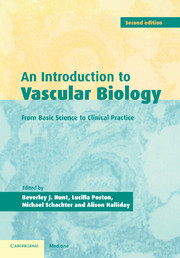Book contents
- Frontmatter
- Contents
- List of contributors
- Preface
- Part I Basic science
- Part II Pathophysiology: mechanisms and imaging
- Part III Clinical practice
- 12 Vascular biology of hypertension
- 13 Atherosclerosis
- 14 Abdominal aortic aneurysm
- 15 The vasculature in diabetes
- 16 The vasculitides
- 17 Pulmonary hypertension
- 18 Role of endothelial cells in transplant rejection
- 19 Vascular function in normal pregnancy and preeclampsia
- Index
14 - Abdominal aortic aneurysm
Published online by Cambridge University Press: 07 September 2009
- Frontmatter
- Contents
- List of contributors
- Preface
- Part I Basic science
- Part II Pathophysiology: mechanisms and imaging
- Part III Clinical practice
- 12 Vascular biology of hypertension
- 13 Atherosclerosis
- 14 Abdominal aortic aneurysm
- 15 The vasculature in diabetes
- 16 The vasculitides
- 17 Pulmonary hypertension
- 18 Role of endothelial cells in transplant rejection
- 19 Vascular function in normal pregnancy and preeclampsia
- Index
Summary
Introduction
The aorta has to withstand the load imposed by arterial blood pressure for a lifetime. The microanatomy of the aorta reflects this burden and the media is thick, composed of numerous concentric lamellae of elastic connective tissue and smooth muscle cells. In youth and health elastin is the principal load-bearing component of the aorta with collagen fibres only being recruited at the highest loads (Burton, 1954). Other microfibrils, including fibrillin-rich fibrils, also contribute to load bearing. The abdominal aorta, distal to the renal arteries, is the aortic segment with least elastin and least nutrient vasa vasorum in the adventitia. With ageing this segment of the aorta is vulnerable to weakening and fusiform aneurysmal dilatation: abdominal aortic aneurysms (AAAs) are present in approximately 5% of men aged 65 years or older.
Definition of an abdominal aortic aneurysm
The normal diameter of the infrarenal aorta is 1.5–2.2 cm, with taller patients tending to have wider aortas. The infrarenal aorta is conveniently assessed by ultrasonography. A localized fusiform dilation is clearly evidenced when the proximal and distal aortic diameters are much smaller than the maximum diameter. One suggested definition of an AAA is when the ratio of maximum diameter to infrarenal diameter exceeds 1.5 cm. However, the resolution and visualization of the suprarenal aorta by ultrasonography are poor. A more convenient and widely accepted definition of an aneurysm is when the maximum anterior–posterior diameter exceeds 3 cm.
- Type
- Chapter
- Information
- An Introduction to Vascular BiologyFrom Basic Science to Clinical Practice, pp. 318 - 326Publisher: Cambridge University PressPrint publication year: 2002

